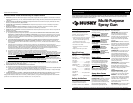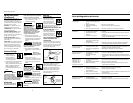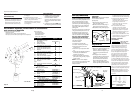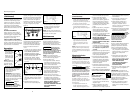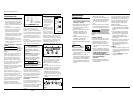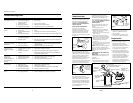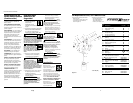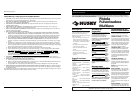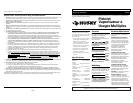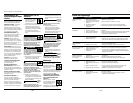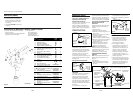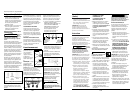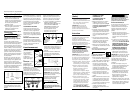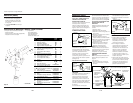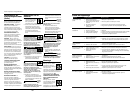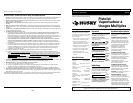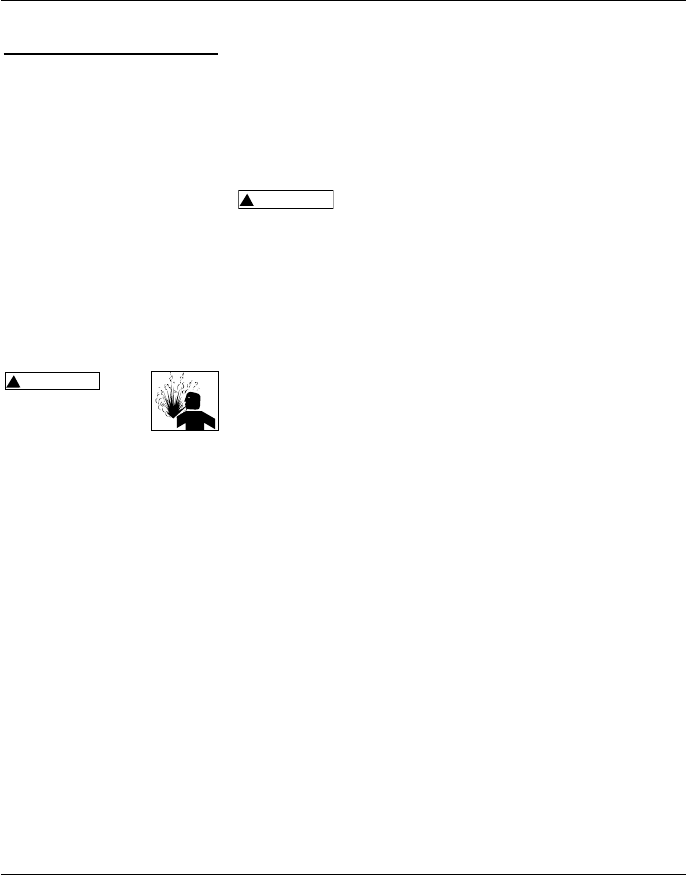
NOTA: Si el material se chorrea, está
aplicando mucho material. Si el
acabado luce “como cáscara de
naranja”, el material está muy espeso.
Si el rocío es demasiado fino (malgasto
excesivo), debido al exceso de aire para
la cantidad de pintura que se está
rociando, reduzca la presión del aire o
abra el control de fluído para rociar
más material.
Si el rocio es muy tosco (gotas), reduzca
la cantidad de material con la perilla de
control de fluído o diluya la pintura.
AJUSTES DE DISTANCIA
Comience a 15,2 cm de la superficie de
trabajo. Si el patrón empieza a
chorrearse, retroceda una pulgada y
pruebe otra vez. El patrón quedará
seco y delgado y puede sentirse tosco al
tacto si se rocía desde muy lejos.
AJUSTES DE LA VELOCIDAD DE
APLICACIÓN
Si la velocidad de aplicación es muy
lenta, la pintura quedará húmeda en la
superficie de trabajo y puede
chorrearse. Si la velocidad de aplicación
es muy rápida, la pintura se secará y no
quedará pareja en la superficie de
trabajo.
Funcionamiento
1. Comience a rociar.
Siempre mantenga
la pistola en los
ángulos correctos
con el movimiento
de la muñeca para
pintar. (Vea la
Figura 6).
NOTA: No mantenga
la muñeca fija cuando
esté usando la pistola,
ni pinte moviendo la
pistola en arcos como
un abanico. Este tipo de movimiento
acerca la pistola a la superficie y crea
dépositos de pintura que se concentran
en el centro del área cubierta aplicando
muy poca pintura en los bordes. Ésto
ocasionaría un acabado irregular y de
mala calidad (Vea la Figura 7).
Mantenga la boquilla de 6 a 9 pulgadas
(15,24 a 22,86cm) de la superficie que
va a pintar todo el tiempo y siempre
mantenga la pistola en movimiento
mientras esté rociando. Si para de
moverla la pintura se acumulará y se
“chorreará”.
2. “Oprima el gatillo” adecuadamente.
Comience a mover la pistola ANTES
DE OPRIMIR EL GATILLO y deje de
oprimirlo ANTES DE PARAR DE
MOVERLA. Este procedimiento le
permitirá que el acabado sea parejo
sin dejar rastros de donde se unen las
diferentes manos de pintura (Vea la
Figura 8).
Preparacion
(Continuación)
3. Llene el envase hasta 3/4 de su
capacidad y encienda el compresor de
aire. Cerciórese de que las mangueras
sean lo suficientemente largas para
permitir el desplazamiento total de la
pistola a lo largo de la superficie que
va a pintar.
4. Cerciórese de que el regulador de la
presión de aire esté fijado al nivel
indicado para el funcionamiento
adecuado de la pistola. Vea las
indicaciones al respecto en la sección
de especificaciones. Oprima el gatillo
y chequée la presión de aire en la
entrada de la pistola.
5. Utilice un pedazo de cartón u otro
material desechable para practicar y
hacer los ajustes necesarios antes de
comenzar a pintar.
AJUSTE DEL MATERIAL / AJUSTE DEL
PATRÓN
Pruebe
siempre la
pistola pulverizadora en material de
desecho para evitar daños a la pieza de
trabajo.
La perilla de control de fluído controla
la distancia que puede oprimir el
gatillo y la cantidad de material que
circula a través de la pistola. (Gire la
perilla en el mismo sentido de las
agujas del reloj para reducir el flujo y
en sentido contrario al de las agujas del
reloj para aumentar el flujo.) Este
ajuste depende, en parte, en la
cantidad de aire que circula a través de
la pistola. El flujo de aire sólo se puede
controlar con el regulador del
compresor de aire.
Rocíe patrones de prueba en un
pedazo de cartón con la pistola a 20,3
cm de la superficie. Oprima el gatillo
para hacer rociados cortos de un
segundo, y haga ajustes con esta perilla
hasta que el patrón de rociado tenga la
forma oval deseada y el material se
distribuya uniformemente sobre la
superficie, sin puntos gruesos o
delgados. El patrón debe quedar
rebajado en los bordes (vea la figura 5).
AVISO
20 Sp
Pistola Pulverizadora Multiuso
Maintenance
(Continued)
4. Clean gaskets with a solvent soaked
rag. To prevent equipment damage,
Do not immerse gaskets or spray
gun body in solvents.
5. After using water to clean out water
based paints or materials, spray
mineral spirits through the gun to
prevent corrosion.
6. Use a non-silicone oil on all moving
parts when reassembling. Use
Vaseline
®
or light grease on all
threaded connections prior to
storage.
7. Clean and flush gun thoroughly to
neutralize any contaminants
corrosive to the spray gun.
CLEANING A GUN USED WITH A PAINT
TANK
Shut off the air supply to
the tank and release the
pressure in the tank.
1. Open the vent on the paint tank. If
using an external mix air cap, loosen
the cap slightly.
2. Reduce air pressure to 10-20 psi.
Hold a piece of wadded cloth tightly
around the air cap opening(s) and
pull the trigger. The air will back up
through the fluid tip and force the
paint out of the hose and back into
the tank.
!
WARNING
5
3. Pour the paint from tank and use
solvent and rags to clean.
4. Put enough solvent into the tank to
wash the hose and gun thoroughly.
Close the tank and spray from the
gun until the solvent comes out
clean.
5. Remove and blow out the material
hose with compressed air to get rid
of any trace of solvent in the hose.
When blowing out
the hose, the open
end should be aimed away from any
person to avoid blowing solvent into
the eyes or on the skin causing possible
injury.
PERIODIC CLEAN-UP
Due to dirty, lumpy paint etc., it may
be necessary to inspect and clean the
internal parts and the gun body.
1. Examine openings in air cap and
fluid tip. If clogged, remove any o-
rings and soak the air cap or fluid tip
in solvent.
2. A brush or toothpick or something
similar may be used to dislodge the
dried paint from holes and passages.
NEVER USE METAL OBJECTS TO
CLEAN PRECISELY DRILLED
PASSAGES. DAMAGED PASSAGES
WILL CAUSE IMPROPER
SPRAYING.
3. Remove and check the adjusting
needle for excessive wear at the tip
and straightness.
!
WARNING
IMPORTANT: If the needle tip is worn
more on one side than the other, either
the needle is bent or the gun body has
been dropped or knocked out-of-line.
There are no adjustments that can be
made to a bent gun body. Test the
needle by rolling on a flat surface.
Replace if necessary.
4. Check and replace any damaged
o-rings and seals. O-rings and seals
can be wiped clean but not soaked in
solvent.
5. Unscrew packing nuts and replace
the packing ONLY if a leak will not
stop when the nut is tightened. Do
not over-tighten a packing nut
because this will restrict movement
of the needle.
6. Reassemble in reverse order of these
steps and use a non-silicone oil on
moving parts. Apply Vaseline
®
or
light grease on threaded joints and
hose connections.
STORING
1. When not using spray gun, turn the
fluid control knob counterclockwise
to open reducing spring tension on
needle fluid tip.
2. Spray gun MUST BEwell cleaned
and lightly lubricated.
Correcto
Pintura
Muy
Espesa
Pintura Muy
Clara (Diluida)
Figura 5 - Consistencia del patrón
(Atomización)
PRESENCIA DE AGUA/ACEITE EN EL
AIRE COMPRIMIDO
Todos los cabezales expulsan cierta
cantidad de agua condensada,
aceite o contaminantes con el aire
comprimido.
IMPORTANTE: Esta condensación
ocasiona un acabado disparejo al
pintar. Le recomendamos que
instale el equipo (tal como filtros y
secadores) y controles necesarios
para remover agua/aceite.
Si no
instala
el equipo adecuado para remover
agua/aceite podría dañar la maquinaria
o superficie que esté pintando .
AVISO
6 - 9”
Figura 6
Muy Poca
Pintura
Demasiada
Pintura
Figura 7
INCORRECTO
Muy Poca
Pintura
6 - 9”
Oprima
el Gatillo
Comienzo
Suelte el
Gatillo
Final
Figura 8



